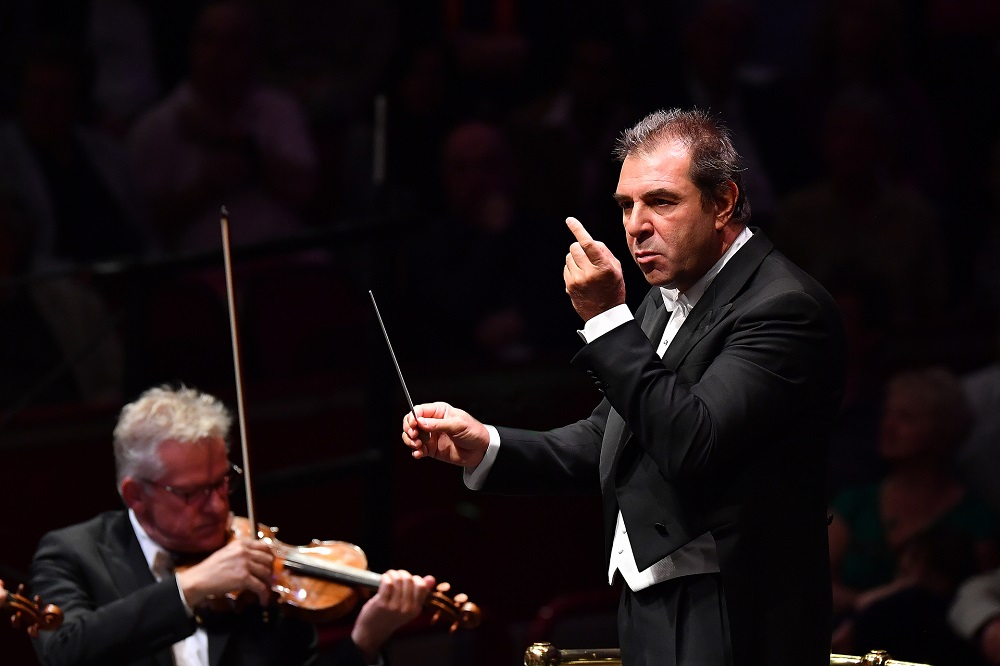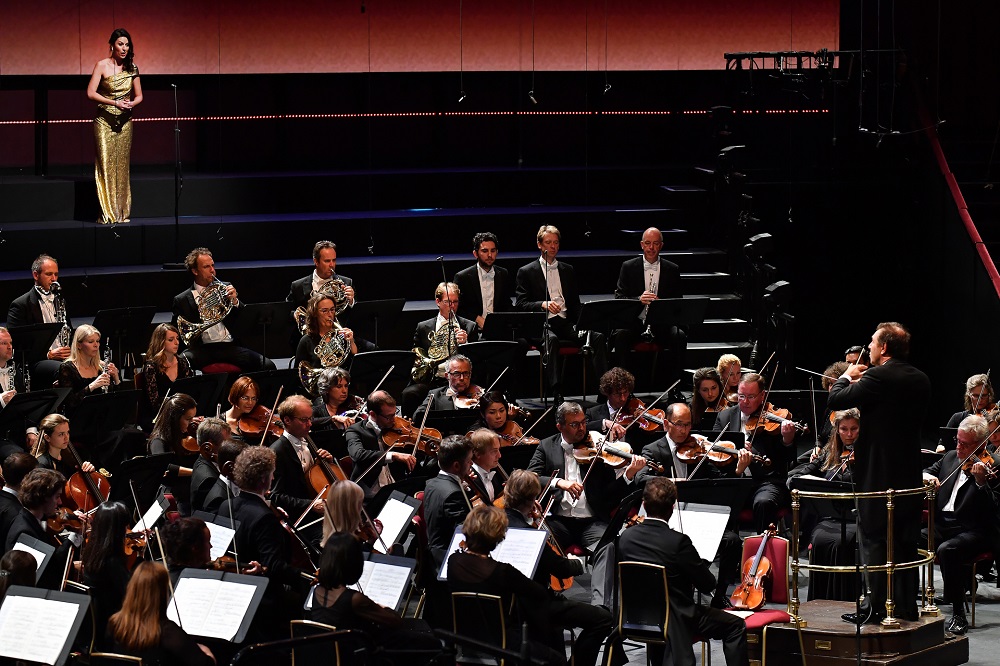Proms 64 & 66 review: Royal Concertgebouw Orchestra, Gatti - halfway to paradise with Bruckner and Mahler | reviews, news & interviews
Proms 64 & 66 review: Royal Concertgebouw Orchestra, Gatti - halfway to paradise with Bruckner and Mahler
Proms 64 & 66 review: Royal Concertgebouw Orchestra, Gatti - halfway to paradise with Bruckner and Mahler
Amsterdam's finest falter on the way to heaven, but get there in the end
How do you get to heaven, especially if you need to reach the pearly gates by way of the earthbound acoustics of the Royal Albert Hall? With Chief Conductor Daniele Gatti as their spirit guide, the sumptuously arrayed pilgrim band of the Royal Concertbegouw Orchestra from Amsterdam sought different routes in the centrepieces of their pair of Proms.
For their first outing, the Concertgebouw prefaced their Bruckner with In-Schrift by the fearsomely productive Wolfgang Rihm. Written in 1995 for the basilica of St Mark’s in Venice, this compact but epic battle between separated groups of instruments begins with an ecclesiastical F sharp clang of five tubular bells from the percussion rank. Below them sit a phalanx of brass, with more horns, cellos and basses in the second row, then woodwind and harp in the front-line. Violins and violas are absent, with leave. If this sounds more military than liturgical, then Rihm’s punchy volleys of sound – as much Stravinsky, who also wrote for St Mark’s, as Gabrieli – make a big, impressively marshalled push to fill an echoing space. The aftermaths of these striking salvos reverberate long and hard. In this hall, the strategy worked well, all the way from ultra-deep bass trombones somewhere in the catacombs to bird-like flutes fluttering up in the eaves. Percussion-driven heartbeats hinted at combat trauma as much as sacred awe. Bongos and woodblocks set up a bat-like chatter while the swaggering heavy brass, in the ascendent all evening, strove to burst into the relief of some full-dress, Wagner-like funeral music. But they always found some interruption in the way.
On Saturday, the Amsterdamers led out Haydn’s Symphony No. 82 – the “Bear” – as a warm-up act for Mahler’s Fourth. Unwise? The Parisians for whom Haydn wrote it thought that the Vivace finale, with its bagpipe-like drone and folksy woodwind on the top, brought to mind music to make a chained beast dance. Well, the orchestra (slimmed down to classical dimensions) sounded a little like some tethered wild thing itself: sleek, hefty but restrained, slightly absent in heart if not in gesture. Could they be just too refined for this sophisticated rusticity, its plain, melodic C major honesty always so artfully complicated without any loss of basic innocence? Haydn in this guise can resemble Queen Marie Antoinette decked out as a shepherdess, and it takes a rare flair to keep up the charade. 
Mahler’s insistence on swinging, relaxed, unhurried tempi meant that Gatti could allow his all-star cast of instrumentalists to shine. Especially in the divine wood-and-brass chit-chat of the scherzo, each voice felt fresh, firm, thoroughly assured and sometimes even cheeky, from the flutes led by Kersten McCall to the oboes (Alexei Ogrintchouk) and the horns (Laurens Woudenberg and friends). By the third movement, the concluding starburst of E major bliss drove all doubts away with a thrilling radiance. Then, behind and above the band, Chen Reiss (pictured above aloft) sang of the child’s heaven with a sweet strength that never cloyed. Mahler and mischief are never too far apart, and she rightly went for sassiness, not schmaltz. For some sopranos, the obligation to sing from behind the Concertgebouw might imply a season in hell rather than paradise. Not here: ethereal but still grounded, Reiss wafted us up into the clouds with an angelic – but never sentimental – touch.
rating
Share this article
Add comment
The future of Arts Journalism
You can stop theartsdesk.com closing!
We urgently need financing to survive. Our fundraising drive has thus far raised £49,000 but we need to reach £100,000 or we will be forced to close. Please contribute here: https://gofund.me/c3f6033d
And if you can forward this information to anyone who might assist, we’d be grateful.

Subscribe to theartsdesk.com
Thank you for continuing to read our work on theartsdesk.com. For unlimited access to every article in its entirety, including our archive of more than 15,000 pieces, we're asking for £5 per month or £40 per year. We feel it's a very good deal, and hope you do too.
To take a subscription now simply click here.
And if you're looking for that extra gift for a friend or family member, why not treat them to a theartsdesk.com gift subscription?
more Classical music
 Bizet in 150th anniversary year: rich and rare French offerings from Palazzetto Bru Zane
Specialists in French romantic music unveil a treasure trove both live and on disc
Bizet in 150th anniversary year: rich and rare French offerings from Palazzetto Bru Zane
Specialists in French romantic music unveil a treasure trove both live and on disc
 Scottish Chamber Orchestra, Ibragimova, Queen’s Hall, Edinburgh review - rarities, novelties and drumrolls
A pity the SCO didn't pick a better showcase for a shining guest artist
Scottish Chamber Orchestra, Ibragimova, Queen’s Hall, Edinburgh review - rarities, novelties and drumrolls
A pity the SCO didn't pick a better showcase for a shining guest artist
 Kilsby, Parkes, Sinfonia of London, Wilson, Barbican review - string things zing and sing in expert hands
British masterpieces for strings plus other-worldly tenor and horn - and a muscular rarity
Kilsby, Parkes, Sinfonia of London, Wilson, Barbican review - string things zing and sing in expert hands
British masterpieces for strings plus other-worldly tenor and horn - and a muscular rarity
 From Historical to Hip-Hop, Classically Black Music Festival, Kings Place review - a cluster of impressive stars for the future
From quasi-Mozartian elegance to the gritty humour of a kitchen inspection
From Historical to Hip-Hop, Classically Black Music Festival, Kings Place review - a cluster of impressive stars for the future
From quasi-Mozartian elegance to the gritty humour of a kitchen inspection
 Shibe, LSO, Adès, Barbican review - gaudy and glorious new music alongside serene Sibelius
Adès’s passion makes persuasive case for the music he loves, both new and old
Shibe, LSO, Adès, Barbican review - gaudy and glorious new music alongside serene Sibelius
Adès’s passion makes persuasive case for the music he loves, both new and old
 Anja Mittermüller, Richard Fu, Wigmore Hall review - a glorious hall debut
The Austrian mezzo shines - at the age of 22
Anja Mittermüller, Richard Fu, Wigmore Hall review - a glorious hall debut
The Austrian mezzo shines - at the age of 22
 First Person: clarinettist Oliver Pashley on the new horizons of The Hermes Experiment's latest album
Compositions by members of this unusual quartet feature for the first time
First Person: clarinettist Oliver Pashley on the new horizons of The Hermes Experiment's latest album
Compositions by members of this unusual quartet feature for the first time
 Gesualdo Passione, Les Arts Florissants, Amala Dior Company, Barbican review - inspired collaboration excavates the music's humanity
At times it was like watching an anarchic religious procession
Gesualdo Passione, Les Arts Florissants, Amala Dior Company, Barbican review - inspired collaboration excavates the music's humanity
At times it was like watching an anarchic religious procession
 Classical CDs: Camels, concrete and cabaret
An influential American composer's 90th birthday box, plus British piano concertos and a father-and-son duo
Classical CDs: Camels, concrete and cabaret
An influential American composer's 90th birthday box, plus British piano concertos and a father-and-son duo
 Cockerham, Manchester Camerata, Sheen, Martin Harris Centre, Manchester review - re-enacting the dawn of modernism
Two UK premieres added to three miniatures from a seminal event of January 1914
Cockerham, Manchester Camerata, Sheen, Martin Harris Centre, Manchester review - re-enacting the dawn of modernism
Two UK premieres added to three miniatures from a seminal event of January 1914
 Kempf, Brno Philharmonic, Davies, Bridgewater Hall, Manchester review - European tradition meets American jazz
Bouncing Czechs enjoy their Gershwin and Brubeck alongside Janáček and Dvořák
Kempf, Brno Philharmonic, Davies, Bridgewater Hall, Manchester review - European tradition meets American jazz
Bouncing Czechs enjoy their Gershwin and Brubeck alongside Janáček and Dvořák
 Solomon, OAE, Butt, QEH review - daft Biblical whitewashing with great choruses
Even a top soprano and mezzo can’t make this Handel paean wholly convincing
Solomon, OAE, Butt, QEH review - daft Biblical whitewashing with great choruses
Even a top soprano and mezzo can’t make this Handel paean wholly convincing

Comments
Emily Beynon wasn't playing
Thanks, updated now. Both
Thanks, updated now. Both principals equally fine. BT